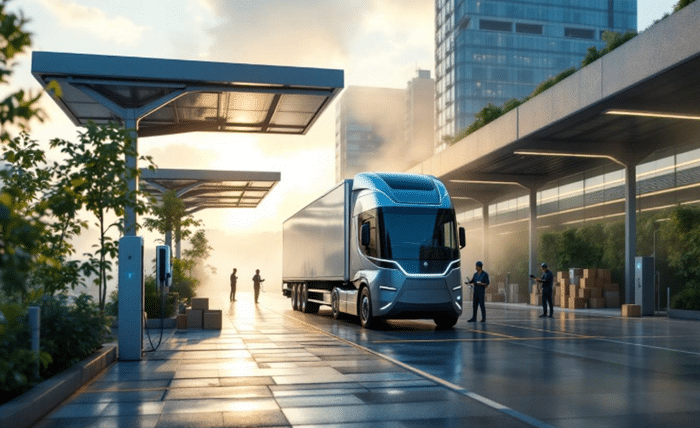
Autonomous trucks are coming, and they’re going to change the way freight moves across the country. To keep up with these self-driving vehicles, truck stops will be transformed into high-tech hubs.
So, what does this mean for truck stops? How will they adapt to serve autonomous fleets? What kinds of technologies will they use? And most importantly, what’s next for these roadside staples as they step into the future? Let’s see.
1. The Rise of Autonomous Trucks
In the near future, autonomous trucks will start rolling out on highways in greater numbers. Companies like Tesla, Waymo, and TuSimple are testing self-driving rigs that offer big benefits:
- Cut labor costs by removing the need for human drivers.
- Improve fuel efficiency by driving more smoothly and efficiently.
- Enhance safety by cutting down on human error, which causes most road accidents.
But there are still hurdles to clear before autonomous trucks become mainstream. Regulations are still being figured out, and not everyone trusts self-driving technology yet. To make this work, truck stops will need to step up and offer services that meet the unique needs of these vehicles.
2. Redesigning Truck Stops for Autonomous Fleets
In the future, truck stops will look very different from the ones we see today. These facilities will be redesigned to cater to autonomous trucks, which don’t need amenities like restrooms or showers. Instead, they’ll focus on features like:
- Drop-Off Zones: Large areas where autonomous trucks can park, load, and unload cargo efficiently.
- Charging Stations: As electric autonomous trucks become more common, truck stops are adding high-capacity chargers to power them.
- Automated Fueling: Robotic arms allow autonomous trucks to refuel without any human help.
- Remote Monitoring: On-site tech centers let fleet managers track vehicle performance and plan repairs in real time.
These changes will mark a shift in the role of truck stops, from serving human drivers to supporting advanced autonomous systems.
3. Smarter Parking Solutions
Parking has always been a challenge, even for human-driven trucks. But with autonomous fleets, efficient parking becomes even more critical. Sensors in parking lots will provide real-time updates on available spaces, helping autonomous trucks find open spots faster. Think of it like reserving a table at a restaurant: some truck stops might even let rigs book parking spots ahead of time, cutting down on congestion and wait times.
This small change could have a big impact. Less time spent searching for parking means more time on the road, which translates to faster deliveries and lower costs for fleets. It’s a win-win for logistics.
4. Maintenance and Repairs at Modern Truck Stops
Imagine an autonomous truck equipped with sensors that detect a tire issue while driving through Texas. It alerts a nearby truck stop, where technicians prepare to fix the problem before the truck even arrives. This kind of proactive maintenance could save fleets hours of downtime.
Mobile repair services will also become more common. Instead of waiting for a truck to reach a shop, technicians will be sent directly to stranded vehicles, especially in remote areas. AI-powered diagnostic tools will help identify issues faster and more accurately than ever before.
5. Serving Both Human and Autonomous Drivers
While autonomous trucks are the future, human drivers will still be around for a while. Many truck stops are finding ways to serve both groups during the transition:
- Showers, food, and lounges are still available for human drivers who may accompany autonomous trucks.
- Over time, some truck stops are cutting back on these amenities to focus on tech-focused services like charging stations and monitoring hubs.
- Training centers might also pop up to help drivers adapt to semi-autonomous vehicles. These hubs will provide hands-on experience with the latest tech, bridging the gap between traditional driving and the future of freight.
Drivers searching for “truck stops near me within 5 mi” might soon find locations offering these training programs alongside traditional amenities.
6. Data-Driven Operations
Big data will play a key role in how truck stops operate in the future. Here’s what that might look like:
- Traffic Insights: Operators will track traffic patterns to predict busy times and allocate resources accordingly.
- Dynamic Pricing: Fuel prices and amenities will adjust based on demand, ensuring resources are used efficiently.
- Personalized Services: Loyalty programs will track driver preferences to offer tailored discounts or recommendations.
- Predictive Maintenance: Systems will alert truck stops when vehicles need repairs before breakdowns occur, reducing downtime.
By integrating tools like truck route GPS, fleet managers can optimize routes and schedules, further streamlining operations. These innovations will help truck stops stay competitive in a rapidly changing industry.
7. Challenges and Opportunities
Adopting new technologies won’t be easy, and truck stops will face their fair share of challenges:
- High Costs: Upgrading facilities with EV chargers, automated fueling systems, and remote monitoring hubs won’t be cheap.
- Resistance to Change: Some traditional truck stop owners might hesitate to embrace high-tech setups.
- Regulatory Uncertainty: Rules for autonomous vehicles are still being worked out, creating uncertainty for everyone involved.
But there are opportunities too. Automation will boost efficiency and profitability. Renewable energy solutions will position truck stops as leaders in sustainability. And partnerships with tech companies will open doors to innovative ideas.
Autonomous trucks are reshaping the logistics industry, and truck stops are evolving to keep up. From automated fueling to AI-powered diagnostics, these facilities are embracing new technologies to support self-driving fleets. As the industry changes, truck stops will play a key role in shaping the future of freight transportation.




